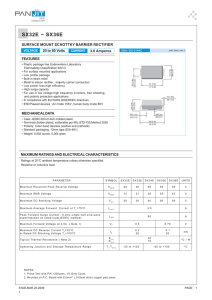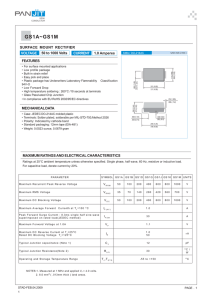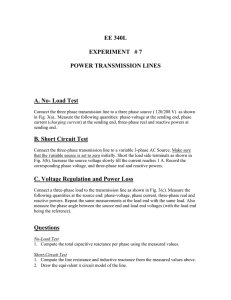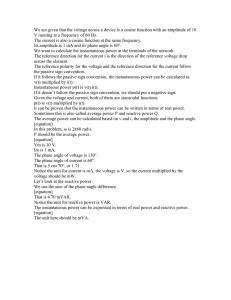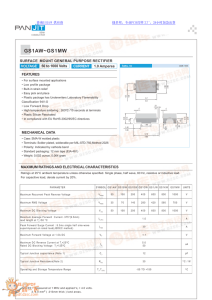instantaneous power control of
advertisement
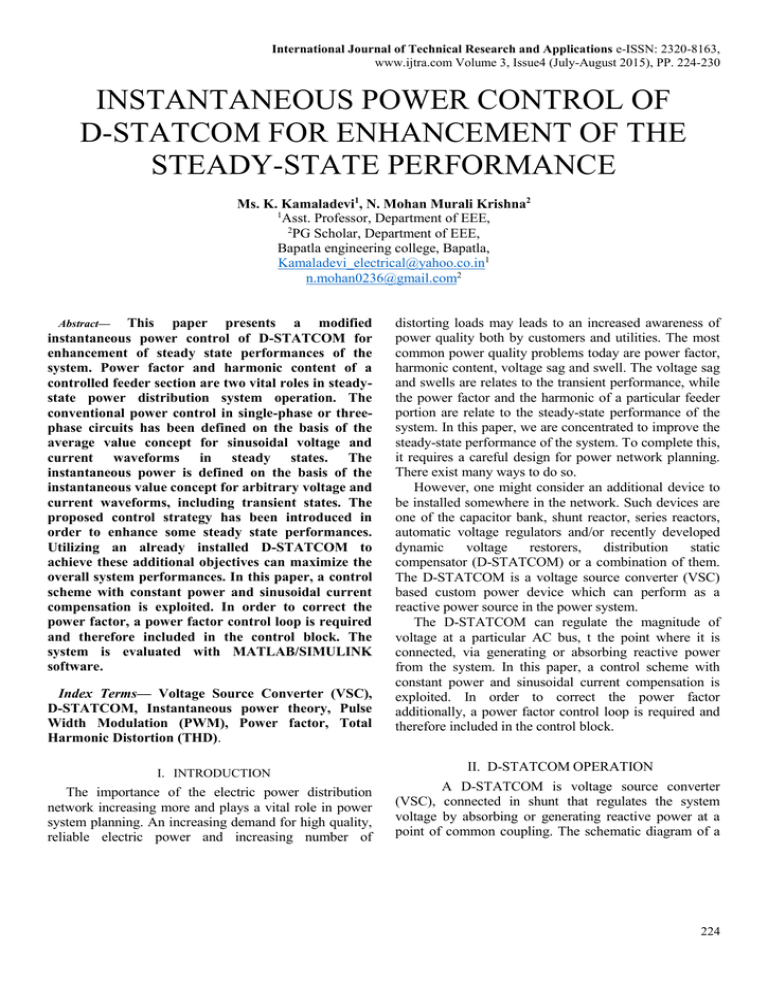
International Journal of Technical Research and Applications e-ISSN: 2320-8163, www.ijtra.com Volume 3, Issue4 (July-August 2015), PP. 224-230 INSTANTANEOUS POWER CONTROL OF D-STATCOM FOR ENHANCEMENT OF THE STEADY-STATE PERFORMANCE Ms. K. Kamaladevi1, N. Mohan Murali Krishna2 1 Asst. Professor, Department of EEE, 2 PG Scholar, Department of EEE, Bapatla engineering college, Bapatla, Kamaladevi_electrical@yahoo.co.in1 n.mohan0236@gmail.com2 Abstract— This paper presents a modified instantaneous power control of D-STATCOM for enhancement of steady state performances of the system. Power factor and harmonic content of a controlled feeder section are two vital roles in steadystate power distribution system operation. The conventional power control in single-phase or threephase circuits has been defined on the basis of the average value concept for sinusoidal voltage and current waveforms in steady states. The instantaneous power is defined on the basis of the instantaneous value concept for arbitrary voltage and current waveforms, including transient states. The proposed control strategy has been introduced in order to enhance some steady state performances. Utilizing an already installed D-STATCOM to achieve these additional objectives can maximize the overall system performances. In this paper, a control scheme with constant power and sinusoidal current compensation is exploited. In order to correct the power factor, a power factor control loop is required and therefore included in the control block. The system is evaluated with MATLAB/SIMULINK software. Index Terms— Voltage Source Converter (VSC), D-STATCOM, Instantaneous power theory, Pulse Width Modulation (PWM), Power factor, Total Harmonic Distortion (THD). I. INTRODUCTION The importance of the electric power distribution network increasing more and plays a vital role in power system planning. An increasing demand for high quality, reliable electric power and increasing number of distorting loads may leads to an increased awareness of power quality both by customers and utilities. The most common power quality problems today are power factor, harmonic content, voltage sag and swell. The voltage sag and swells are relates to the transient performance, while the power factor and the harmonic of a particular feeder portion are relate to the steady-state performance of the system. In this paper, we are concentrated to improve the steady-state performance of the system. To complete this, it requires a careful design for power network planning. There exist many ways to do so. However, one might consider an additional device to be installed somewhere in the network. Such devices are one of the capacitor bank, shunt reactor, series reactors, automatic voltage regulators and/or recently developed dynamic voltage restorers, distribution static compensator (D-STATCOM) or a combination of them. The D-STATCOM is a voltage source converter (VSC) based custom power device which can perform as a reactive power source in the power system. The D-STATCOM can regulate the magnitude of voltage at a particular AC bus, t the point where it is connected, via generating or absorbing reactive power from the system. In this paper, a control scheme with constant power and sinusoidal current compensation is exploited. In order to correct the power factor additionally, a power factor control loop is required and therefore included in the control block. II. D-STATCOM OPERATION A D-STATCOM is voltage source converter (VSC), connected in shunt that regulates the system voltage by absorbing or generating reactive power at a point of common coupling. The schematic diagram of a 224 International Journal of Technical Research and Applications e-ISSN: 2320-8163, www.ijtra.com Volume 3, Issue4 (July-August 2015), PP. 224-230 D-STATCOM is shown in Fig.1. The D-STATCOM is a solid AC/DC power switching converter that consists mainly of a three-phase PWM voltage source converter bridge having six IGBTs with associated anti-parallel diodes. A DC link capacitor provides constant DC link voltage to the voltage source converter (VSC). instantaneous space vectors, and are set on the aaxis and their amplitude, direction vary with the passage of time. In the same way, and and on the b-axis, and are on the c-axis. These space vectors are easily transformed into coordinates as follows. (1) Fig.1. Simplified power system equipped with DSTATCOM From the DC input voltage, provided by the charged capacitor, the converter produces a set of controllable three-phase output voltages at the frequency of AC power system.Each output voltage is in phase with the corresponding AC voltage bus via coupling reactance. The reactive power exchange between the D-STATCOM and the AC system is controlled by varying the magnitude of output voltage produced. If the AC system voltage is decreased from a reference value, then the DSTATCOM injects the reactive power into the system. Similarly, if the AC system voltage is increased above the reference value, then the D-STATCOM absorbs the reactive power from the AC system. D-STATCOM acts as a shunt compensator connected in parallel to the system so that it can inject appropriate compensation currents. The D-STATCOM has several advantages compared to a conventional static var compensator (SVC). The D-STATCOM gives faster response and can produce reactive power at low voltages. Also, it doesn’t require thyristor-controlled reactors (TCR) or thyristor-switched capacitors. III. INSTANTANEOUS P-Q THEORY In the three-phase, three-wire systems, there is no zero sequence components. If and are both neglected, instantaneous voltage v, and current phasors i, can be defined from their corresponding instantaneous α and β components as follows. v= +j (3) i= +j (4) From (3) and (4), instantaneous complex power, s, can be defined as the product of the instantaneous voltage phasor and the complex conjugate of the instantaneous current phasor given in (5). s=v =( +j )( j )=p+jq (5) Where To deal with the instantaneous voltages and currents in three-phase circuits mathematically, it is adequate to express their quantities as the instantaneous space vectors. The instantaneous p-q theory is very useful not only in the steady-state but also in transient-state for both three-phase systems with or without neutral conductor. For simplicity, the three-phase voltages and currents components will be considered in the following. In a-b-c coordinates, the a, b and c axis are fixed on the same plane, apart from each other by (2) p= + is the instantaneous active power q= is the instantaneous reactive power The instantaneous complex power is useful. It can be applied for transient or steady-state analysis. The following equation is compact from for the instantaneous real and reactive power definition and its inversion. These two powers can be separated into average . The 225 International Journal of Technical Research and Applications e-ISSN: 2320-8163, www.ijtra.com Volume 3, Issue4 (July-August 2015), PP. 224-230 components ( and and ) and oscillating components ( ) as shown in (8) and (9). = (6) = p= (7) + q= + (8) (9) The average values of both p and q agree with conventional real and reactive powers in AC circuits. The oscillating terms that naturally produce a zero mean give additional oscillating power flow without contribution on the energy transfer neither from the source to the load nor from load to the source. Fig.2. Concept of shunt current compensation Fig.3. Control block of shunt current compensation based on the instantaneous power theory One important application of the instantaneous power theory is the shunt current compensation as shown in the Fig. 2. To achieve the compensation, the oscillating components of p and q must be eliminated. The powers to be compensated can be simply determined by eliminating the oscillating real and reactive power components. The instantaneous current references to minimize the oscillating terms can be established with some concepts. Fig.3. Shows a general idea of shunt current compensation based on instantaneous p-q theory. IV. PROPOSED CONTROL SCHEME To enhance the performance of the distribution system, D-STATCOM was connected to the distribution system. In general, power compensation by DSTATCOM can have various functions such as elimination of power oscillation, improvement of power factor, elimination of harmonic current, etc. Under a balanced three-phase supply condition, some criteria must meet to optimize the overall system compensation. The researches conducted shows that the source current becomes purely sinusoidal and delivers minimal average power to the load. The power factor correction of a protected load can be included in the control scheme by zeroing the reactive power supplied by the source. The compensator must supply the oscillating power components to the load. In order to compensate the oscillating power flow by means of PWM converters, the DC voltage across the DC link capacitor must be large enough and kept constant at that value to stabilize the compensation. Therefore, DC link voltage regulator must be added to the control loop. To separate the oscillating real power components a low-pass filter is used. Together with the switching and ohmic losses of the PWM converter, the instantaneous real power is formed. Similarly, the instantaneous reference can be set to zero to achieve the unity power factor. The PWM generator is a device that generates the sinusoidal waveform or signal. To operate PWM generator, the angle is summed with the phase angle of balance supply voltages equally at 120 degrees. Therefore, it can produce the desired synchronizing signal that required. PWM generator also receives the error signal angle from PI controller. In practice, the reference signals for generating the switching pattern to drive IBGT gates are current waveforms, equation (7) is modified to equate the compensating current in αβ coordinates as expressed in the following equation (10). Therefore, the αβ current is transformed back to the a-b-c coordinates for the switching pattern generation as 226 International Journal of Technical Research and Applications e-ISSN: 2320-8163, www.ijtra.com Volume 3, Issue4 (July-August 2015), PP. 224-230 described by the equation (11). Depending upon these equations, the reference signals to the PWM converter will be provided. Nonlinear load DC capacitor for D-STATCOM Interface inductor Reference DC link voltage With the power factor correction, the reactive power regulation is also added to the loop as shown in Fig. 4. 3-phase full wave rectifier drawing a Dc current of 50A 300 µF , The test system is a 22-kv power distribution feeder with three-phase rectifier loading is shown in the Fig. 6. Fig.4. Proposed control scheme with reactive power regulation The overview of the proposed control scheme can be depicted as shown in Fig. 5 Fig.6. 22-kv power distribution feeder with threephase rectifier loading The MATLAB/SIMULINK diagram of the test system is shown in the Fig. 7. Fig.5. Overall proposed control scheme V. SIMULATION RESULTS To verify the use of the proposed control scheme in order to correct the power factor and compensate harmonic content, a test system using MATLAB/SIMULINK was implemented. Table I gives information of the test system. TABLE I PARAMETERS OF THE TEST SYSTEM VALUES SYSTEM PERAMETERS Supply Voltage 22KV, 50Hz RL balance load R=50 Ω , L= 100mH Fig.7. Simulation diagram of the test system The test was divided into two cases. The first case was used the conventional control scheme. Whereas, the second case was the proposed control scheme given in this paper. In the conventional control scheme, the power 227 International Journal of Technical Research and Applications e-ISSN: 2320-8163, www.ijtra.com Volume 3, Issue4 (July-August 2015), PP. 224-230 factor control loop and the instantaneous power control loop were not implemented. Both the tests were assigned to be operated with the same instruction or in the same environment conditions. The test system was started from zero initial conditions with only rectifier load. At t = 0.2 s, the D-STATCOM was connected to the system via the point of common coupling. At t = 0.5 s, the RL load or the reactive load is switched on to increase the system loading. A. Case I : In the conventional scheme, the system responds without D-STATCOM in the time interval 0-0.2 s was shown in Fig. 8. At t = 0.2 – 0.5 s, the D-STATCOM was connected to the system to compensate the nonlinear load as the response is shown in Fig. 9. It can be seen that the course current was shaped to be nearly sinusoidal. However, due to the PWM operation of D-STATCOM, higher-order harmonic components were inevitably experienced. At t ≥ 0.5 s when the RL load is switched on, the current was lagged the voltage at the point of common coupling by 21.6 degrees, corresponding power factor is 0.9298 lagging as shown in Fig. 9. Fig.10. Response during t ≥ 0.5 s for case I B. Case II : With the control strategy proposed in this paper, the system response without D-STATCOM in the time interval 0 – 0.2 s was shown in fig. 11. At t = 0.2 – 0.5 s, the D-STATCOM was connected to compensate the nonlinear load as response shown in Fig. 12. It can be seen that the source current was shaped to be nearly sinusoidal. However, due to PWM operation of DSTATCOM, higher-order harmonic components were inevitably experienced. At t ≥ 0.5 s when the RL load switched, the source current that was previously lagged the voltage at the point of coupling connection in case I was resumed to in-phase with the voltage waveform. This described the success of power factor correction by the reactive power control scheme made in this paper. This can be seen in Fig. 13. Fig.8. Response during t = 0 – 0.2 s for case I Fig.1 1. Response during t = 0 – 0.2 s for case II Fig.9. Response during t = 0.2 – 0.5 s for case I Fig.12. Response during t = 0.2 – 0.5 s for case II 228 International Journal of Technical Research and Applications e-ISSN: 2320-8163, www.ijtra.com Volume 3, Issue4 (July-August 2015), PP. 224-230 Fig.13. Response during t ≥ 0.5 s for case II C. Comparison: This section gives the comparison between the results from both cases. Real powers, reactive powers and DC link voltages of each case were observed and then compared. Figs. 14 – 16 present the comparison of which for real power, reactive power, DC link voltage and the harmonic spectrum of the source current waveforms respectively. The response of observed reactive powers clearly confirmed that during the overall operation, the proposed control scheme can well perform the function of power factor correction. This can be seen with nearly zero reactive power for case II in Fig. 15. Fig.14. Comparison regulation of instantaneous real Fig.16. Comparison of DC link voltage regulation D. THD Analysis The THD analysis is carried over the distribution system without the installation of the D-STATCOM and on the proposed test system. The results shows that the conventional system having the THD value of 29.3% as shown in the harmonic spectrum of Fig.17. While, the proposed test system has the THD value of 0.12% as shown in the Fig. 18. The results show that the proposed test system having very less harmonic content than the conventional system. According to IEEE standards, a system having THD below 5% is a good system. power Fig.15. Comparison of instantaneous reactive power regulation Fig.17. THD analysis of the system without installation of D-STATCOM. Fig.18. THD analysis of the proposed test system 229 International Journal of Technical Research and Applications e-ISSN: 2320-8163, www.ijtra.com Volume 3, Issue4 (July-August 2015), PP. 224-230 VI. CONCLUSION This paper introduces a modified control scheme to compensate the non-linear loads on a distribution feeder. The simulation results shows that The regulation of the real powers delivering to loads Correction of power factor Regulation of Dc link voltage Reduction of harmonics in the source current Modification of control scheme made in this paper is to add the reactive power regulation into the loop. With zero reactive power reference, near to unity power factor is achieved. By reducing the harmonic content and increasing the power factor of the system, the steadystate performance enhancement is achieved. REFERENCES [1] H. Akagi, Instantaneous Power Theory and Applications to Power Conditioning, New Jersey, USA: Wiley, 2007. [2] H. Akagi, Instantaneous Reactive Power Compensators comprising switching Devices without Energy Storage Components, IEEE Trans, June 1984. [3] Mahesh k. Mishra, “A Voltage Controlled DSTATCOM for Power Quality Improvement”, IEEE Trans, 2014 [4] J. A. Momoh, Electric Power Distribution, Automation, Protection & Control, New York, USA: CRC Press, 2008 [5] E. H. Wantanabe, “Instantaneous p-q Power Theory for Compensating Non-sinusoidal System”, IEEE, 2008. [6] N. G . hingorani and L. Gyugyi, Understanding FACTS concept and Technology of Flexible AC Transmission System, New York, USA: IEEE Press, 2000. [7] N. G. Hingorani, “Introducing Custom Power”, IEEE Spectrum, June 1995. [8] A. L. Olimpo and E. Acha, “Modelling and Analysis of Custom Power systems by PSCAD/EMTDC:,IEEE Ttans. Jan 2002. [9] P. Pohjanheimo and E. Lakervi, “Steady State Modelling of Custom Power Components in Power Distribution Networks”, IEEE Trans, Jan 2000. [10] A. Adys, “Application of D-STATCOM for isolated systems”, IEEE Conf., Nov 2004. [11] K. Somsai and T. Kulworawanichpong, “Modelling, Simulation and control of D-STATCOM using ATP/EMTP”, In ICHQP 2008. [12] C. Sumpavakup and T. Kulworawanichpong, “Distribution Voltage Regulation under three-phase fault by using D-STATCOM”, The international Conference on Electrical Power and Energy Systems, July 2008. 230
